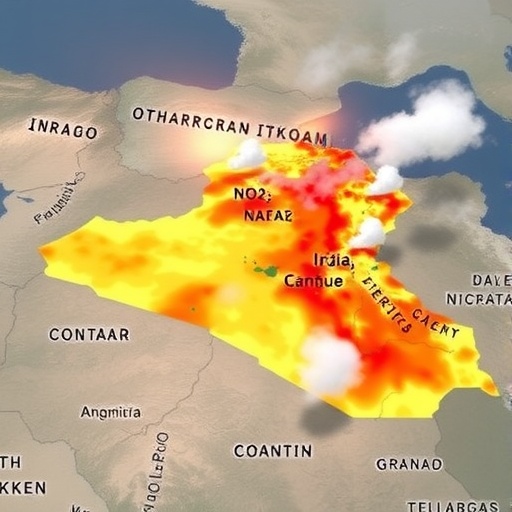Amid an escalating global consciousness concerning air quality, a recent study sheds compelling light on the intricate tapestry of air pollution in Iraq. Notably, the findings by researchers Onojeghuo and Rasul illuminate the severity of air pollution exposure in various hotspots throughout the region. Central to their study is a comprehensive analysis of critical pollutants, including carbon monoxide (CO), nitrogen dioxide (NO2), sulfur dioxide (SO2), particulate matter (PM2.5), and aerosols, all of which emerge as focal points of environmental concern. The work not only enhances our understanding of the pollution landscape in Iraq but also serves as a call to action in addressing the pressing environmental and health challenges posed by these contaminants.
As nations continue to grapple with the implications of air pollution, the research conducted in Iraq stands out for its granularity and relevance. The researchers employed advanced techniques to identify pollution hotspots, utilizing robust data collection methods that included satellite imagery, ground-based monitors, and statistical analyses. Through these methodologies, they were able to delineate areas where concentrations of harmful pollutants are alarmingly high. This spatial mapping of pollution hotspots is crucial in forming targeted interventions that can mitigate the impact of air quality deterioration on public health.
An alarming feature of the study reveals that urban centers in Iraq are particularly susceptible to high levels of air pollution. Areas with dense traffic, industrial activities, and limited regulatory oversight emerge as significant contributors to elevated concentrations of pollutants. The research highlights how urbanization and industrialization, while essential for economic development, must be balanced with environmental stewardship. By addressing the dual challenge of fostering economic growth while preserving air quality, public health can be significantly enhanced.
Moreover, the researchers found a direct correlation between pollution levels and respiratory health issues among the population. Individuals residing in the identified hotspots exhibited a higher prevalence of conditions such as asthma, chronic obstructive pulmonary disease, and other respiratory disorders. This association underscores the intertwined nature of environmental health and public well-being, reinforcing the necessity for immediate action to address air pollution in these vulnerable areas. It is imperative for policymakers to not only recognize this relationship but also to implement strategies that will curb emissions from the identified sources.
Public awareness about air pollution and its health impacts is crucial to fostering community-level engagement in environmental protection initiatives. The study advocates for educational programs aimed at informing the citizens of Iraq about the dangers associated with air pollution and the importance of advocating for cleaner air. Such efforts can empower communities to demand better regulatory practices and engage in behaviors that minimize individual contributions to pollution.
Another significant aspect of the research is its methodology, which employed satellite data in conjunction with ground-level measurements. This hybrid approach allowed for a more comprehensive assessment of air quality across different terrains and altitudes. By integrating technological advances with traditional monitoring techniques, the researchers demonstrated how modern tools can vastly improve our understanding of environmental pollutants. This innovative combination can serve as a model for similar studies in other regions facing air quality challenges worldwide.
The findings also indicate that seasonal variations play a crucial role in the distribution of air pollutants. For instance, during certain times of the year, natural phenomena such as dust storms exacerbated the concentration of PM2.5 levels, illustrating the complexity of Iraq’s air quality dynamics. This observation suggests that any effective air quality management strategy must consider not only anthropogenic sources but also natural factors that contribute to pollution levels.
The implications of the research extend beyond Iraq, providing valuable insights for other nations grappling with similar environmental issues. As urban populations continue to swell globally, the data underscores a universal need for robust air quality management frameworks. By sharing findings from Iraq, the researchers contribute to the broader discourse on air pollution, urging other nations to examine their own environmental policies and practices carefully.
Moreover, the capacity for multidisciplinary approaches in tackling air pollution is reinforced by this study. Collaboration among environmental scientists, public health experts, urban planners, and policymakers can facilitate comprehensive strategies that address air quality on multiple fronts. Such collaboration is essential in forging pathways toward sustainable urban development while ensuring the well-being of the populace.
Regional conflicts and instability also exacerbate the air pollution crisis in Iraq, as ongoing tensions often result in neglect of environmental regulations and inadequate enforcement of existing laws. This precarious context highlights the need for stable governance and international cooperation in addressing air quality issues. Foreign governments and organizations might play a critical role in supporting vulnerable nations through funding, technology transfer, and best practices in environmental management.
The research further emphasizes the necessity for effective monitoring and reporting systems to gauge air quality continuously. Implementing an accessible platform for the dissemination of air quality information can empower communities to make informed decisions regarding their health and well-being. Providing real-time data on pollution levels could rally public interest and action, ultimately paving the way toward cleaner air for future generations.
In conclusion, the work of Onojeghuo and Rasul significantly augments the body of knowledge surrounding air pollution in Iraq, establishing a framework that not only identifies crucial pollutants and their hotspots but also posits various avenues for action. Their study encapsulates the urgent need to analyze and address the intertwined realms of environmental health and public policy. As the global community continues to forge ahead in combating air pollution, lessons learned from Iraq’s challenges may inspire more concerted efforts towards cleaner air and a healthier planet.
Subject of Research: Air pollution exposure and hotspots of various pollutants in Iraq.
Article Title: Air pollution exposure and hotspots of CO, NO2, SO2, PM2.5, and aerosols in Iraq.
Article References:
Onojeghuo, A., Rasul, A. & Onojeghuo, A. Air pollution exposure and hotspots of CO, NO2, SO2, PM2.5, and aerosols in Iraq.
Environ Monit Assess 197, 1226 (2025). https://doi.org/10.1007/s10661-025-14571-9
Image Credits: AI Generated
DOI: 10.1007/s10661-025-14571-9
Keywords: air pollution, CO, NO2, SO2, PM2.5, aerosols, hotspots, Iraq, environmental health, pollutants, urbanization.




